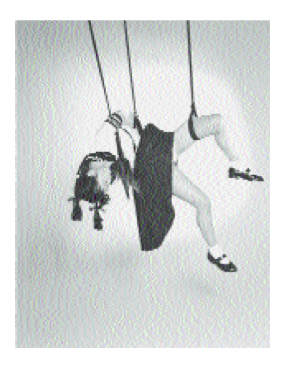Nobuyoshi Araki, Japan’s most famous and prolific photographer, has published some three hundred books over a forty-year career. In Araki: Self, Life, Death, a retrospective collection just released by Phaidon, there are black-and-white pictures of Tokyo, looking gloomy and grimy, and nude shots of many women, including his wife, Yoko, who died in 1990. There are photos of cats and skies. Flip further through the book, however, and you’ll find, nestled amid the cityscapes and nudes, a section entitled Kinbaku, devoted to photos of women in bondage. Some are hog-tied; others are suspended from ceilings, naked, like enormous, fleshy piñatas.
“I only tie up a woman’s body,” Araki likes to say, “because I know I cannot tie up her heart.” A lover of many things Japanese, Araki, sixty-five, draws inspiration from the intricate rope bondage style of shibari, which includes ties from the takate kote (a simple arm tie) to the more difficult ebi (“shrimp”).
Shibari traces its roots to medieval Japan, when young samurai were taught various ways to use rope to bind and torture prisoners. As with handcuffs and gimp masks, a few adventurous souls discovered the sensual pleasures of rope bondage, and an art form was born. Images of shibari found their way onto Japan’s popular ukiyo-e woodblock prints, along with pictures of randy octopi and men with genitals the size of baguettes. Today, shibari aficionados celebrate this ancient art everywhere from Germany and the Netherlands to Chicago, site of an annual shibari convention.
Araki is no great shakes as a nawashi, or master of ropes. “He uses the same patterns over and over again,” says Master “K,” author of The Art of Shibari. One of Araki’s favorites is the yokosuri, in which the bindee is suspended sideways with one leg hanging down. “Of course, he’s one of Japan’s greatest photographers,” says K, “so a lot of this talk about patterns and ties are the kind of arcane things that only people who are passionate about shibari would care about.” Midori, author of The Seductive Art of Japanese Bondage and a self-described “teacher of adventurous sex,” agrees. “When I’m looking at his photographs I’m not looking at it from a technical aspect,” she says. “I’m taking the whole for the pleasure of it, or for the pleasure of allowing myself to be disturbed by it.”
Are the shibari pictures sexy? Some of Araki’s fruits and mouths are sexier. His Mapplethorpian flowers, to be sure, are just filthy. The book mixes the overtly sexual (nudes), the tangentially erotic (clouds, koi), and the off-putting (preteen-looking sex workers, vagina close-ups). Araki contributes numerous brief writings to the book, many translated in English for the first time, in which he discusses why he likes certain cameras and recalls the time, not so long ago, that he “really fell for” a grade school girl.
Araki: Self, Life, Death also includes four critical essays that, despite term-paper titles, dig deep into Araki’s art and motivations. For fans who like their dirty pictures uninterrupted by such elevated topics there’s always Araki’s 1990 Tokyo Lucky Hole, a look at Shinjuku’s thriving sex scene, but then one would miss the philosophical clashes between Araki’s writings and these essays. In “Everything Is Photography: Nobuyoshi Araki, the Absolute Photographer,” curator Akiko Miki discusses Araki’s work as “a manifestation of revolt against the repressive nature of Japan’s regimented society.” The photographer dismisses such explanations. “I have sex,” he says in the book, “so I can take good pictures.” He also takes good pictures so he can have sex—he often boasts about making love with his models—and takes pictures of sex acts because, as with cats and cities, he finds these things visually captivating. And sexy, too, although, after 720 pages of fruits that look like genitals and bound women that look like hanging fruit, the line between the erotic and the creepy tends to blur.





